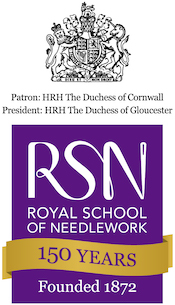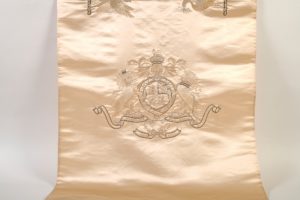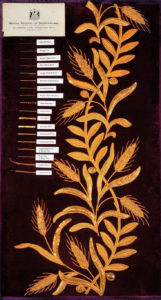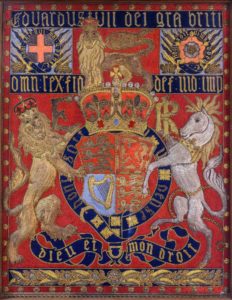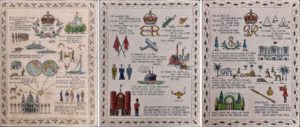Fit for a Queen
150 Years of the RSN: Virtual Exhibition
The RSN worked commissions for members of the royal family from the earliest days, both domestic pieces and court garments, but it really became known for its work on Queen Victoria’s funeral pall. No commercial company would take the commission as it was needed too quickly. Princess Helena said, ‘my school will do it’. From the time the order was agreed, to the finished pall leaving the building, was just 48 hours and the actual embroidery was completed in 21 hours of continuous stitching by 45 women. The pall was later described as the one bright spot on a very sad day. This piece established the second of the RSN’s mantras, that ‘when on a rush job, never a seat shall go cold’.
The RSN was then asked to work on pieces for Edward VII and Queen Alexandra including coronation regalia in 1902, following which an exhibition of coronation garments was held in aid of the RSN. The School has subsequently made items for every coronation of the twentieth century through to Her Majesty Queen Elizabeth II’s Robe of Estate, which will be on show at Windsor Castle this year. On display here is the sampler that was made in 1953 for the coronation exhibitions in Birmingham and Leeds
.In addition to coronation pieces, the RSN has made many other items, including Garter banners, lingerie and personal gifts for members of the royal family, as well as a wedding dress.
Cover of Black and White Magazine
April 1902
Magazine cover
Following the success of Queen Victoria’s funeral pall, the RSN was asked to work on elements of the coronation of Edward VII and Queen Alexandra – not everything, as the royal family were keen to share the work around. The main piece that the RSN worked was the mantle or Pallium of the King which is worn for the actual crowning. Here a journalist has obviously visited the RSN workroom to draw this image. While clothes and hairstyles may have changed methods of working have not. Such was the interest that is notable that this was the front cover of the magazine.
Hanging for the Silver Wedding of Edward and Alexandra
1888
Silk satin fabric and cotton, silk and metal embroidery threads
This is an unusual piece made by the RSN for the silver wedding anniversary of the Prince and Princess of Wales featuring the Prince of Wales’s feathers, the initials of the couple and on one side the year of the wedding and on the other the year of the silver anniversary. It looks as though it should be folded but at the centre point are two embroidered sections that would not have been folded.
Sampler of Queen Elizbeth II’s Robe of Estate
1953
Silk velvet, metal thread embroidery felt, framed
The RSN was asked to design and embellish the Robe of Estate for Queen Elizabeth II in 1953. The theme was peace and plenty and this was represented by wheat ears and olive branches. This sampler was made by the RSN for the Coronation regalia exhibition that went to Birmingham and Leeds in 1953 when the Robe itself was on display elsewhere. It also features the 18 varieties of gold thread that were used in the work. NB The Robe of Estate will be on display at Windsor Castle from July to September 2022. The robe took 3,500 hours to embroider, and the work was undertaken by a core of 12 women including Miss Ruby Essam, Miss Violet Wise, Miss Margaret Bartlett. The press were only allowed in on one occasion so the images did not give any real idea of the finished work before the day.
Samplers for George V, Edward VIII, and George VI
1935, 1937, 1937
Designed by Lady Smith-Dorrien
Painted canvas and linen mounted
In 1935 RSN Principal Lady Smith-Dorrien decided to create a sampler for the Silver Jubilee of George V. It was an unusual approach to a sampler with contemporary pictures and verse and was very popular. The press in particular picked up on George V being the first monarch whose voice had been heard by the people. Owing to the success of the first sampler, two more were created for Edward VIII, although the last verse shows it to be post abdication, and for George VI which features the curly E for his wife Elizabeth and images of the two Princesses.
